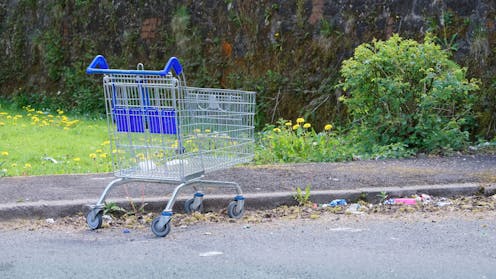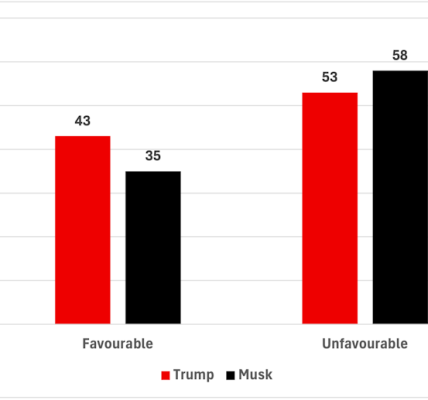Counting the climate costs of abandoned shopping trolleys
Despite the steady growth of online shopping, a majority of the UK public still prefers to buy groceries at the supermarket.
Shopping trolleys can help us lug our purchases back to the car, but some shoppers are evidently taking them further afield. In 2017, 520,000 trolleys were reported as abandoned in the UK. Sunderland in north-east England alone reported 30,000 abandoned trolleys between 2020 and 2022. Likewise, 550 trolleys were collected in a single day in western Sydney, Australia.
Supermarkets employ a range of methods to stop trolleys leaving their premises, including coin slots, vertical bars (to stop trolleys leaving the shop floor), wheel-locking mechanisms and car park wardens. Despite these efforts, abandoned trolleys still blight the landscape and need to be collected.
Many supermarkets use commercial collection services, such as Wanzl TrolleyWise or TMS Collex. These companies typically use diesel vans to survey suburban areas, collect trolleys and return them to supermarkets. They also offer to refurbish weathered or damaged trolleys, sometimes by applying a zinc-based coating to protect against corrosion – a process known as regalvanisation.
We are researchers at the University of Warwick who wanted to understand the environmental impact of trolley abandonment. So, we set out to investigate it.
Collecting versus manufacturing
How does the environmental impact of using vans to rescue abandoned trolleys compare with losing these trolleys to excessive damage or corrosion and having to make new ones?
Our study used a standardised methodology known as life-cycle assessment to analyse the potential environmental impact of collecting and handling abandoned shopping trolleys within an area of Coventry, a city in the English West Midlands, which includes our university campus.
We spoke to trolley suppliers, who told us trolleys used at the supermarket in Coventry were most likely made in Spain. This was incorporated into our model.
A trolley discovered by the author, abandoned in a bush near a car park.
Neill Raath
Through conversations with our university’s estates department and commercial collection services, we established that approximately 30 trolleys were collected a week on average in the area surrounding the Tesco supermarket in the Cannon Park shopping centre.
Our model assumed that a bulk transport of 50 trolleys is sent twice each year to be refurbished, in a round trip of 220km between Coventry and a refurbishment facility based in the UK that was noted on stickers placed on refurbished trolleys.
Vans collecting 520,000 abandoned trolleys in a year could emit the equivalent of 343 tonnes of CO₂ (the annual equivalent of driving 80 petrol cars). If we imagine that 10% of these 520,000 trolleys have been left outside too long and need to be regalvanised then the total global warming impact increases by 90% to the equivalent of 652 tonnes CO₂ (roughly the same as 152 petrol cars being driven for one year).
This is quite a surprising increase for such a small number of trolleys. It suggests that the real problem lies with the environmental impact of manufacturing.
Most of the emissions can be avoided
We found that one trolley would have to be collected 93 times by a diesel van to have the same environmental impact as manufacturing a new one.
Our results showed that the emissions incurred during the diesel van collection phase were only 1% of the manufacturing impact, and the regalvanisation stage was only 8%. We might wonder whether switching to electrically powered collection vans might help. While the emissions would be reduced, the impact of using diesel vans is still minuscule compared to that of making new trolleys.
We found that the highest environmental impact stemmed from manufacturing, which was mainly attributed to making and replacing the steel frame of the trolley.
These results reinforce the benefits of following the circular-economy principle of keeping trolleys in use for as long as possible, and avoiding manufacturing to replace abandoned ones.
Would anything change if we switched to plastic trolleys? Other researchers have investigated the effect of changing trolley materials and have found that trolleys made of polymers have many benefits compared with steel: they use less material, are less dense (a benefit for collection vans that emit less by driving around lighter products) and do not require protective coatings, which themselves have an environmental impact.
Blast furnaces at conventional steelworks are very carbon-intensive.
Pedal to the Stock/Shutterstock
However, if these polymer trolleys were to be sent to landfill (or left to deteriorate in the environment), they could release carcinogenic chemicals, as well as microplastics, as they break down. This leads us back to the importance of keeping products in use.
Abandoning trolleys is bad for the environment, with a potential global warming impact equivalent to 0.69 kg CO₂ for collecting one trolley and returning it to a supermarket. If we multiply this by the potential 520,000 abandoned trolleys a year, this figure becomes quite big.
Preventing trolley abandonment should be a priority not just for supermarkets, but for the general public as well. However, once a trolley is abandoned, it is far better to collect and refurbish it than to let it fall out of use and manufacture a new one, as 92–99% of the environmental impact can be avoided.
While it is unlikely that we can ever stop trolleys being abandoned, we hope that next time people see a trolley in an alley or park bush, the potential environmental impact of losing this trolley to service would be apparent.
Don’t have time to read about climate change as much as you’d like?
Get a weekly roundup in your inbox instead. Every Wednesday, The Conversation’s environment editor writes Imagine, a short email that goes a little deeper into just one climate issue. Join the 45,000+ readers who’ve subscribed so far.
The authors do not work for, consult, own shares in or receive funding from any company or organisation that would benefit from this article, and have disclosed no relevant affiliations beyond their academic appointment.


